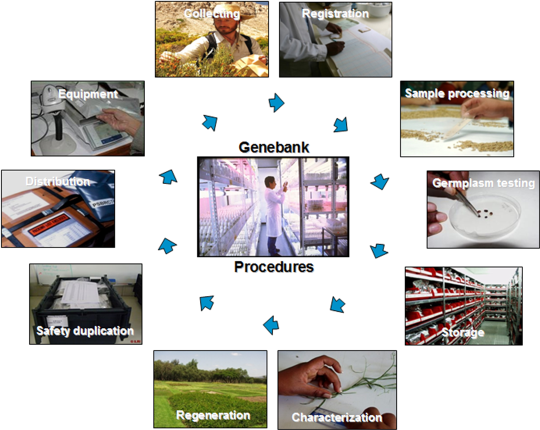Genebank procedures
Contact person for Procedures: Jean Hanson, ILRI, Ethiopia
Page compiled by: Bioversity International/ILRI, Addis Ababa, Ethiopia (Alexandra Jorge); ILRI, Addis Ababa, Ethiopia (Jean Hanson) including information extracted from: Rao NK, Hanson J, Dulloo ME, Ghosh K, Nowel D and Larinde M. 2006. Manual of seed handling in genebanks. Handbooks for Genebanks No. 8. Bioversity International, Rome, Italy. 147pp.
Plant genetic resources genebanks are the repositories of the world’s huge diversity of crop varieties and their wild relatives. They ensure that the varieties and landraces of the crops and their wild relatives that underpin our food supply are adequately collected, stored, and maintained in the long term and are made available and distributed for use by farmers, plant breeders and researchers.
|
|
Genebanks conserve genetic resources. The most fundamental activity in a genebank is to treat a new sample in a way that will prolong its viability as long as possible while ensuring its genetic integrity. The samples (or accessions as they are called) are monitored to ensure that they are not losing viability. A cornerstone of genebank operations is the reproduction—called regeneration—of its plant material. Plant samples must periodically be grown out, regenerated, and new seed harvested because, even under the best of conservation conditions, samples will eventually die.
However, genebanks are not built just to conserve genetic resources; they are intended to ensure that these resources are adequately collected and used, whether it is in farmers’ fields, breeding programmes or in research institutions. This means making sure the collections are properly characterized and documented; and that the documentation is available to those who need it. The information systems used by genebanks are becoming increasingly important tools for researchers and breeders seeking data on the distribution of crops and their wild relatives.
Finally, genebanks must be able to deliver healthy samples to the farmers, breeders and researchers.
There are different kinds of genebanks. The most common are:
- Seed banks.
- Field genebanks.
- In vitro –slow growth.
- Cryobanks.
- Vegetative banks.
- DNA banks.
In addition, other specific parts of the plant, such as pollen and leaves, are now being conserved and these collections can also be referred to as genebank or germplasm collections.
Comments
- No comments found






Leave your comments
Post comment as a guest